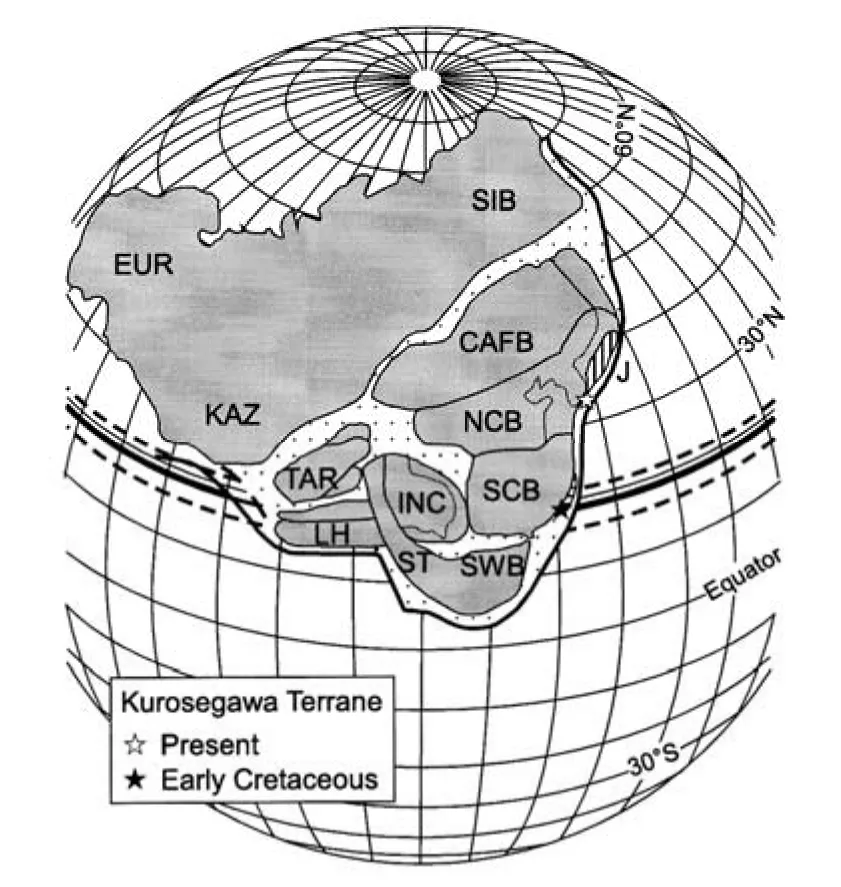黑濑川地体源于亚洲大陆东缘何处?
2012-09-20SHIGEKIHADA,KOJIUNO,KUNIYUKIFURUKAWA
黑濑川地体源于亚洲大陆东缘何处?
E-mail: hada@mailgate.kobe-u.ac.jp.
Working Hypothesis:The difference of fusulinacean assemblages of accreted terranes that composed of subduction complex in the Pacific Rim reflects the characteristics of fusulinid fauna in the mid-Permian in the east Tethys-Panthalassa region.
Attestation of the idea:Fig. 2 shows the results of paleontological analysis of accreted terranes in the Pacific Rim. The method is to combine the characteristic fusulinacean assemblages of terranes and the time of their accretion dated by radiolarian fossils contained in ocean-plate materials.
The seamounts originated in theColania-Lepidolinaterritory docked earlier than those situated in theNeoschawagerina-Yabeinaterritory in Japan in the Northern Hemisphere. Similar relationship with Japan is observed in accreted terranes in the western continental margin of North America (Fig. 2).By contrast, the reverse order of accretion is recognized in New Zealand in the Southern Hemisphere(Fig. 2). These results of analysis clearly indicate that theColania-Lepidolinaterritory spread out in the paleo-equatorial area in Panthalassa, and theNeoschawagerina-Yabeinaterritory in the lower latitudes below theColania-Lepidolinaterritory of the Southern Hemisphere in mid-Permian time.
This conclusion is also supported by the evidences that Triassic cherts from the Jurassic-earliest Cretaceous terrane in Japan yielded paleolatitude of 5.6°±2.2°S (Ando et al., 2001) and Permian limestones from the Jurassic-earliest Cretaceous terrane yielded that of 12°S (Kirschvink and Isozaki, 2007).

Fig. 1 Tectonic map of East Asia showing the distribution of continental blocks and the Kurosegawa Terrane in Japan(after Uno, Furukawa , Hada, 2011)

Fig. 2 Paleogeographic distribution of the Colania-Lepidolina and Neoschwagerina-Yabeina territories in east Paleo-Tethys and Panthalassa deduced from the characteristic fusulinacean assemblages of terranes composed of subduction complex in the Pacific Rim and the timing of their accretion. Arrows indicate the track of accreted seamounts in the Pacific Rim(from Hada et al., 2001)

Fig. 3 Paleogeographical reconstruction showing the relative positions of the East Asian and Chinese blocks in mid-Permian time (modified after Scotese and McKerrow, 1990), and the Colania-Lepidolina territory (shaded portion)
Application of the idea: The idea was applied to analysis of the Kurosegawa Terrane. Limestones of the Kurosegawa Terrane are very different from those of accreted terranes in containing detritus of continental affinity, and formed under shallow-marine conditions along a continental margin. It yields fusulinid fauna of theColania-Lepidolinaterritory, so that the source continent of the terrane must have been located in theColania-Lepidolinaterritory in mid-Permian time. A most probable candidate for the source of the Kurosegawa Terrane is the South China Block (Fig. 3).
Paleomagnetic evidence:A new paleomagnetic study of the Kurosegawa Terrane illustrates latitudinal translation of continental fragments of the Kurosegawa Terrane (Fig. 4).

Fig. 4 Age versus paleolatitude plot for the Kurosegawa Terrane and continental blocks in the East Asian continental margin (after Uno, Furukawa, Hada, 2011)
Paleolatitudes for continenatal fragments of the Kurosegawa Terrane are determined for the Late Triassic (3.5°±3.8°N) and Early Cretaceous(18.4°±2.5°N) times (Fig. 4). These paleomagnetic data and plate reconstruction of East Asia clearly indicates that the terrane was the easternmost element of the South China Block at least from the Late Triassic to the Early Cretaceous. The terrane was then translated northward from the continental margin to its present position, associated with large-scale sinistral strike-slip movement along the East Asian continental margin in mid- to Late Cretaceous times (Figs. 4 & 5).
Which Continental Block in the East Asian Continental Margin is the Source of the Kurosegawa Terrane?
Shigeki HADA1), Koji UNO2), Kuniyuki FURUKAWA3)
1)Faculty of Literature, Kobe Women’s University, Japan;
2)Graduate School of Education, Okayama University, Japan;
3)Faculty of Business Administration, Aichi University, Japan
The point at issue:The Kurosegawa Terrane is composed of continental fragments transecting Mesozoic terranes of accretionary complex in Southwest Japan (Fig. 1). It is an attenuated tectonic sliver and considered to be allochthonous with respect to the main part of Southwest Japan. The problem of which continental block in the East Asian continental margin is the source of the Kurosegawa Terrane has puzzled Japanese geologists for many years.
Firstly, we try to approach this issue based on the analysis of fusulinacean assemblage in accreted terranes composed of subduction complex in the Pacific Rim.
Secondly, by applying the result of this analysis we try to locate the source of the continental fragments of the Kurosegawa Terrane.
Thirdly, we try to prove its validity with a new paleomagnetic study.
Kurosegawa Terrane; Fusulinacean; South China Block; Paleomagnetic
10.3975/cagsb.2012.s1.07

Fig. 5 Early Cretaceous (146-100 Ma) reconstruction of the Eurasian continent after Enkin et al., 1992. Bold and dashed lines represent observed paleolatitude for the Kurosegawa Terrane and its 95% confidence limits, respectively. Solid and open stars show restored and present-day positions of the Kurosegawa Terrane. An area with vertical stripes denotes the inner arc of the Japanese Islands. INC: Indochina Block; J: Japan;NCB: North China Block; SCB: South China Block; SWB:Southwest Borneo Block (after Uno, Furukawa, Hada, 2011)
